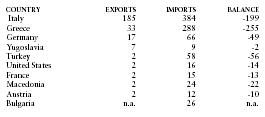Albania - Foreign trade
Before World War II, about 50% of the exports consisted of the entire production of chrome ore and crude oil and some timber; the balance consisted of agricultural goods and fish. Good grains, sugar, and coffee made up about 20% of the imports; textiles, about 24%; and paper, machinery, chemicals, leather, metals, and oil products, about 53%. As the value of imports almost tripled that of exports, the deficit was met largely by Italian loans. Italy received two-thirds of Albanian exports and supplied Albania with up to half its imports. Under the Communist government, foreign trade became a state monopoly. The volume of turnover increased substantially and the structure and orientation changed radically.
As of the year 2000, Albania was running a trade deficit of $814 million (US dollars), a considerable increase since the 1990s. The expansion in imports was largely due to increased domestic demand for foreign goods, as well as increased demand for electronics. Between 1950 and 1967, trade volume increased sixfold, to L 1,043 million in 1967. Total trade volume (imports plus exports) rose 49% between 1966 and 1970. In 1960, trade with the socialist states accounted for about 90% of total trade; the Soviet share of this was half. Political and economic differences between Albania and the USSR resulted in suspension of aid to and trade with Albania. In 1961, 54% of total foreign trade was with the USSR and 7% with China; by 1964, trade with the former had ceased entirely, while trade with China had risen to 55%. After the Albanian-Chinese split in the late 1970s, economic contacts with China ceased. Talks aimed at renewing trade between the two nations were held in 1983, resulting in trade agreements worth about $5–7 million.
In 2000, Albania exported leather products, apparel, footwear components, tobacco products, and metal ores. The production of chromium ore, formerly an integral part of the Albanian export schedule, has plummeted in recent years. Imports in 2000 included raw materials, machinery, transportation equipment, fuel, minerals, metals, and foodstuffs. Albania exported its goods primarily to Italy, Greece, and Germany. The chief sources of Albania's imports were Italy, Greece, Germany, Turkey, Bulgaria, and the Former Yugoslav Republic of Macedonia.
In 2000 Albania's imports were distributed among the following categories:

| Consumer goods | 18.4% |
| Food | 19.2% |
| Fuels | 8.9% |
| Industrial supplies | 32.6% |
| Machinery | 13.1% |
| Transportation | 7.7% |
| Other | 0.1% |
Principal trading partners in 2000 (in millions of US dollars) were as follows:

| COUNTRY | EXPORTS | IMPORTS | BALANCE |
| Italy | 185 | 384 | -199 |
| Greece | 33 | 288 | -255 |
| Germany | 17 | 66 | -49 |
| Yugoslavia | 7 | 9 | -2 |
| Turkey | 2 | 58 | -56 |
| United States | 2 | 16 | -14 |
| France | 2 | 15 | -13 |
| Macedonia | 2 | 24 | -22 |
| Austria | 2 | 12 | -10 |
| Bulgaria | n.a. | 26 | n.a. |